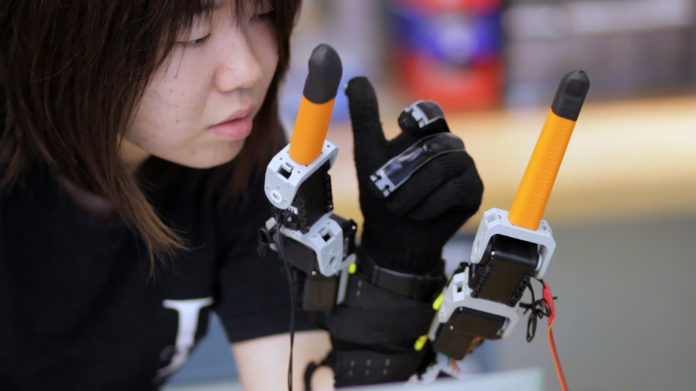Bionic Fingers Could Lend a Helping Hand With Daily Tasks

A new robotic device could make simple, everyday tasks — such as peeling a banana or unscrewing the cap from a water bottle — even easier.
Developed by researchers at the Massachusetts Institute of Technology, the “supernumerary robotic fingers” device is a wrist-mounted robot equipped with two long digits. A specially designed algorithm controls the digits, enabling them to move in sync with the wearer’s real fingers.
“This is a completely intuitive and natural way to move your robotic fingers,” Harry Asada, a professor of engineering at MIT, said in a statement. “You do not need to command the robot but simply move your fingers naturally. Then the robotic fingers react and assist your fingers.”
The algorithm that controls the bionic digits is based on two general patterns of motion, the same patterns that people use when grasping an object. The first pattern involves bringing the fingers together, and the second involves twisting the fingers inward.
Using just these simple gestures, the robotic fingers let users do things with one hand that would normally require two hands. For example, the bionic fingers can hold a jar while your real fingers unscrew the top.

Faye Wu uses the “supernumerary robotic fingers” device to open a container.
Image: Melanie Gonick/MIT
Though it has mastered these simple motions, there’s still a lot that this handy robot can’t do. However, the researchers said they’re working on ways to improve the prototype device.
For instance, the researchers are examining how the wrist-mounted device can adapt to handling heavier objects, and how the fingers should be positioned to grip things that are slippery.
The researchers are also hoping to develop a way for the robot to grasp things according to a user’s specific preferences.
Certain gestures, such as grabbing an apple, vary from person to person. A robotic device that learns its user’s preferences for handling objects — something the researchers call machine learning — could be very useful, said Faye Wu, a graduate student of mechanical engineering at MIT, who worked on the project with Asada. She said the robot could learn in a similar way to Siri, the voice-controlled personal assistant on Apple’s iPhones.
“After you’ve been using [Siri] for a while, it gets used to your pronunciation so it can tune to your particular accent,” Wu said. “Long-term, our technology can be similar, where the robot can adjust and adapt to you.”
Asada also has high hopes for future applications of the robotic fingers. One day, the device could be used by people with limited dexterity, he said. But before the robot becomes really useful, Asada said it will likely require a redesign.
“This is a prototype, but we can shrink it down to one-third its size, and make it foldable,” Asada said. “We could make this into a watch or a bracelet where the fingers pop up, and when the job is done, they come back into the watch. Wearable robots are a way to bring the robot closer to our daily life.”
- CDC Warns Against Travel to Ebola-Affected Countries
- Tethered Blimps Could Be Legal Alternative to Drones
- Coral Crypt: Photos of Damage from the 2010 Deepwater Horizon Oil Spill
- Withings Smart Body Analyzer Review
This article originally published at LiveScience here

